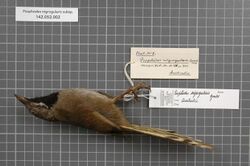Biology:Black-throated whipbird
| Black-throated whipbird | |
|---|---|

| |
| Scientific classification | |
| Domain: | Eukaryota |
| Kingdom: | Animalia |
| Phylum: | Chordata |
| Class: | Aves |
| Order: | Passeriformes |
| Family: | Psophodidae |
| Genus: | Psophodes |
| Species: | P. nigrogularis
|
| Binomial name | |
| Psophodes nigrogularis Gould, 1844
| |
The black-throated whipbird (Psophodes nigrogularis) is a passerine bird found in several scattered populations in Southwest Australia. It is predominantly olive green in colour. It was formerly considered to be conspecific with the white-bellied whipbird (Psophodes leucogaster), so shares the common name "western whipbird".
Taxonomy
The black-throated whipbird was described by the English ornithologist John Gould in 1844 and given its current binomial name Psophodes nigrogularis.[2]
Two subspecies are recognised.[3] Both are under threat to some degree.
- Psophodes nigrogularis nigrogularis: (Endangered) The western heath subspecies is now restricted to a small patch east of Albany, having disappeared from large parts of its range due to land clearance.[4]
- P. n. oberon: (Rare) The western mallee subspecies is found in scattered populations between the Stirling Ranges and Ravensthorpe. It is apparently common in the Fitzgerald River National Park.[5]
The white-bellied whipbird (Psophodes leucogaster) was formerly treated as conspecific with the black-throated whipbird. It was promoted to species status based on an analysis of mitochondrial DNA sequences published in 2017.[6] The Clements Checklist refers to this species with the common name western whipbird (black-throated) to distinguish it from P. leucogaster (white-bellied).[7]
Description
The black-throated whipbird is a slim bird some 21–25 cm (8.3–9.8 in) in length. It is predominantly olive green with a black throat and a narrow white cheek-patch edged with black on its face. It has a small crest and a long dark olive-green tail tipped with white, its underparts are a paler olive colour. The bill is black with blackish feet. Juveniles are a duller olive-brown in colour and lack the white cheek stripes and dark throat.[8]
Breeding
Breeding occurs in spring. The nest is a bowl of twigs and sticks lined with softer material such as grasses, located in shrubs or trees less than 1–2 m (3–7 ft) above the ground. A clutch of two eggs, pale blue with blackish splotches and spots, measuring 26 mm × 19 mm (1.0 in × 0.7 in), is laid.[9]
References
- ↑ BirdLife International (2016). "Psophodes nigrogularis". IUCN Red List of Threatened Species 2016: e.T22705330A94013438. doi:10.2305/IUCN.UK.2016-3.RLTS.T22705330A94013438.en. https://www.iucnredlist.org/species/22705330/94013438. Retrieved 12 November 2021.
- ↑ Gould, John (1844). The Birds of Australia. 3. London: self. Plate 16 and text. https://biodiversitylibrary.org/page/48285744.
- ↑ Gill, Frank; Donsker, David, eds (2018). "Australasian babblers, logrunners, satinbirds, painted berrypeckers, wattlebirds, whipbirds". World Bird List Version 8.1. International Ornithologists' Union. http://www.worldbirdnames.org/bow/au_babblers/.
- ↑ Garnett. p158
- ↑ Garnett. p159
- ↑ Burbidge, A.H.; Joseph, L.; Toon, A.; White, L.C.; McGuire, A.; Austin, J.J. (2017). "A case for realigning species limits in the southern Australian whipbirds long recognised as the Western Whipbird (Psophodes nigrogularis)". Emu 117 (3): 254–263. doi:10.1080/01584197.2017.1313685. Bibcode: 2017EmuAO.117..254B. https://figshare.com/articles/dataset/A_case_for_realigning_species_limits_in_the_southern_Australian_whipbirds_long_recognised_as_the_Western_Whipbird_i_Psophodes_nigrogularis_i_/4898063.
- ↑ "Clements Checklist: Updates & Corrections – August 2017 | Clements Checklist" (in en). Cornell University. http://www.birds.cornell.edu/clementschecklist/updates-corrections-august-2017/.
- ↑ Field Guide to the Birds of Australia. Ringwood, Victoria: Viking O'Neil. 1993. pp. 392. ISBN 0-670-90478-3.
- ↑ Beruldsen, G (2003). Australian Birds: Their Nests and Eggs. Kenmore Hills, Qld: self. pp. 346. ISBN 0-646-42798-9.
Sources
- Garnett, S. (1993) Threatened and Extinct Birds Of Australia. Royal Australasian Ornithologists Union. National Library, Canberra. ISSN 0812-8014
Wikidata ☰ Q1922967 entry
 |


